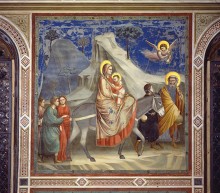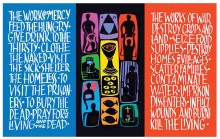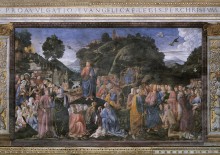Flight into Egypt by Giotto di Bondone
A series of frescoes by Giotto (1266–1337) in the Scrovegni Chapel in Padua follow the life of Christ. In this image, Mary is clearly the dominant figure. Her strength as she holds Jesus on her lap is immediately conveyed. Giotto uses monumental rock forms to direct the viewer’s attention to the Madonna and Child. Joseph is deemphasized on the right side of the composition: he turns away in conversation with a member of the entourage while the guiding angel looks directly at Mary. Giotto portrays Mary as protector of the Christ child and, by extension, of the church.




